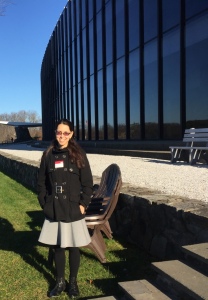When I reached IBM’s Watson research center, I’d barely seen Aaron in three weeks. Aaron is an experimentalist pursuing a physics PhD at Caltech. I eat dinner with him and other friends, most Fridays. The group would gather on a sidewalk in the November dusk, those three weeks. Light would spill from a lamppost, and we’d tuck our hands into our pockets against the chill. Aaron’s wife would shake her head.
“The fridge is running,” she’d explain.
Aaron cools down mechanical devices to near absolute zero. Absolute zero is the lowest temperature possible,1 lower than outer space’s temperature. Cold magnifies certain quantum behaviors. Researchers observe those behaviors in small systems, such as nanoscale devices (devices about 10-9 meters long). Aaron studies few-centimeter-long devices. Offsetting the devices’ size with cold might coax them into exhibiting quantum behaviors.
The cooling sounds as effortless as teaching a cat to play fetch. Aaron lowers his fridge’s temperature in steps. Each step involves checking for leaks: A mix of two fluids—two types of helium—cools the fridge. One type of helium costs about $800 per liter. Lose too much helium, and you’ve lost your shot at graduating. Each leak requires Aaron to warm the fridge, then re-cool it. He hauled helium and pampered the fridge for ten days, before the temperature reached 10 milliKelvins (0.01 units above absolute zero). He then worked like…well, like a grad student to check for quantum behaviors.
Aaron came to mind at IBM.
“How long does cooling your fridge take?” I asked Nick Bronn.
Nick works at Watson, IBM’s research center in Yorktown Heights, New York. Watson has sweeping architecture frosted with glass and stone. The building reminded me of Fred Astaire: decades-old, yet classy. I found Nick outside the cafeteria, nursing a coffee. He had sandy hair, more piercings than I, and a mandate to build a quantum computer.

IBM Watson
“Might I look around your lab?” I asked.
“Definitely!” Nick fished out an ID badge; grabbed his coffee cup; and whisked me down a wide, window-paneled hall.
Different researchers, across the world, are building quantum computers from different materials. IBMers use superconductors. Superconductors are tiny circuits. They function at low temperatures, so IBM has seven closet-sized fridges. Different teams use different fridges to tackle different challenges to computing.
Nick found a fridge that wasn’t running. He climbed half-inside, pointed at metallic wires and canisters, and explained how they work. I wondered how his cooling process compared to Aaron’s.
“You push a button.” Nick shrugged. “The fridge cools in two days.”
IBM, I learned, has dry fridges. Aaron uses a wet fridge. Dry and wet fridges operate differently, though both require helium. Aaron’s wet fridge vibrates less, jiggling his experiment less. Jiggling relates to transferring heat. Heat suppresses the quantum behaviors Aaron hopes to observe.
Heat and warmth manifest in many ways, in physics. Count Rumford, an 18th-century American-Brit, conjectured the relationship between heat and jiggling. He noticed that drilling holes into canons immersed in water boils the water. The drill bits rotated–moved in circles–transferring energy of movement to the canons, which heated up. Heat enraptures me because it relates to entropy, a measure of disorderliness and ignorance. The flow of heat helps explain why time flows in just one direction.
A physicist friend of mine writes papers, he says, when catalyzed by “blinding rage.” He reads a paper by someone else, whose misunderstandings anger him. His wrath boils over into a research project.
Warmth manifests as the welcoming of a visitor into one’s lab. Nick didn’t know me from Fred Astaire, but he gave me the benefit of the doubt. He let me pepper him with questions and invited more questions.
Warmth manifests as a 500-word disquisition on fridges. I asked Aaron, via email, about how his cooling compares to IBM’s. I expected two sentences and a link to Wikipedia, since Aaron works 12-hour shifts. But he took pity on his theorist friend. He also warmed to his subject. Can’t you sense the zeal in “Helium is the only substance in the world that will naturally isotopically separate (neat!)”? No knowledge of isotopic separation required.
Many quantum scientists like it cold. But understanding, curiosity, and teamwork fire us up. Anyone under the sway of those elements of science likes it hot.
With thanks to Aaron and Nick. Thanks also to John Smolin and IBM Watson’s quantum-computing-theory team for their hospitality.
1In many situations. Some systems, like small magnets, can access negative temperatures.

My quantum systems engineering colleagues and I have spent many wonderful hours at Dan Rugar’s Laukien Prize-winning cryogenic nano-science laboratory at IBM Almaden Laboratory; these experiences informed my quantum-physics observations that were posted earlier this week, as comments comments #71 and #74, on Scott Aaronson’s thought-provoking essay “Why Does the Universe Exist?”.
Needless to say, there’s plenty more to be said, and plenty more books to be written, regarding the wonderful topic of low-temperature quantum dynamics and noise.
Pingback: Bringing the heat to Cal State LA | Quantum Frontiers
Pingback: Upending my equilibrium | Quantum Frontiers
Pingback: It’s CHAOS! | Quantum Frontiers
Pingback: Local operations and Chinese communications | Quantum Frontiers
Pingback: Glass beads and weak-measurement schemes | Quantum Frontiers
Pingback: Decoding (the allure of) the apparent horizon | Quantum Frontiers
Pingback: Gently yoking yin to yang | Quantum Frontiers
Pingback: I get knocked down… | Quantum Frontiers
Pingback: Chasing Ed Jaynes’s ghost | Quantum Frontiers
Pingback: “A theorist I can actually talk with” | Quantum Frontiers
Pingback: Quantum information in quantum cognition | Quantum Frontiers
Pingback: Квантовая физика и формирование квантового сознания через квантовую запутанность | ТЕХНОЛОГИИ, ИНЖИНИРИНГ, ИННОВАЦИИ
Pingback: An equation fit for a novel | Quantum Frontiers
Pingback: An equation fit for a novel |
Pingback: Eleven risks of marrying a quantum information scientist | Quantum Frontiers
Pingback: Life among the experimentalists | Quantum Frontiers
Pingback: Quantum computing vs. Grubhub | Quantum Frontiers
Pingback: Quantum computing vs. Grubhub – My Blog